Counterfeit $100 Banco Nacional de México notes
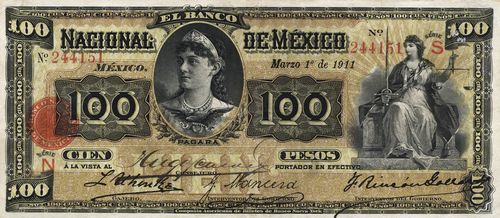
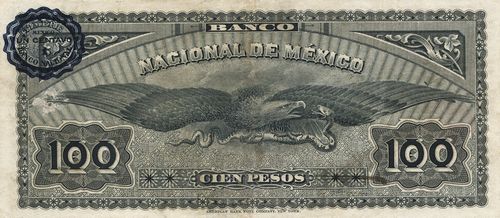
a genuine $100 note
On 7 April 1900 the Secretario de Hacienda, José Limantour, told Carlos de Varona, the bank’s director, that he had been reliably informed that $300,000 in counterfeit $100, $500 and $1,000 notes (predominantly in $100 notes) were being placed into circulation in Chihuahua. It seems that the notes were produced in the United States and the people charged with putting them into circulation had come from San Antonio, TexasCEHM, Fondo CDLIV Colección José Y. Limantour, 2a. 1900, carpeta 8, legajo 17611.
The American Bank Note Company’s correspondenceABNC includes reports of three (or four) different instances of counterfeit Banco Nacional notes.
John Roberts, November 1909
The most competent was made by a Mr. Roberts in El Paso in November 1909 but these counterfeits did not manage to reach circulation. John C. Roberts had made a careful study of Mexican money whilst he was employed as an engineer on a Mexican railroad, and spent five years in New York experimenting in producing counterfeits until his work became almost perfect. He arranged with a printer, William Koenig, to print one million pesos in $100 notes, and deciding that that would be enough for any man, then threw the plates into the Ohio River. Unfortunately his brother, Marion Roberts, took a few notes and tried to interest a broker, J. M. Fetter & Co., in a complicated swindle. The brokers informed the Chief of Police who contacted the Secret Service. They arrested Marion, who in turn led them to John. On 19 August 1910 John was arrested at Simpsonville, near Louisville, Kentucky, by Deputy United States Marshal William Blaydes, and found to have the $1,000,000 in a brass bound trunkEl Paso Morning Times, Vol. 29, No. 20, 20 August 1909; New York Tribune, 20 August 1909: Bisbee Daily Review, Vol. XII, No. 204, 21 August 1909.
In October John pleaded guilty and was sentenced to six years in the federal prison at Atlanta. Marion, tried on the same charge, was acquittedSan Francisco Call, 14 October 1909. Because of his ill health John Roberts was pardoned by President Wilson in December 1913, after serving four yearsThe Allentown Leader, Allentown, Pennsylvania, 16 December 1913.
April 1913
In April 1913 some people were apprehended in El Paso, Texas with $1,000,000 in $100 notes, though all but $10,000 was seized by the bank. These could be most easily identified by the differences in colour, “especially as the forged notes were circulated quite new without being made to appear old and used”.
At the same time very good counterfeit $100 notes were reported by the Banco Nacional’s branch in Agusacalientes, which had received them from the local branch of the Banco de Londres y México. The ABNC’s resident agent, Charles Blackmore, on studying the note at the request of the bank's secretary, A. Legorreta, agreed that the paper used was very similar, there was close resemblance in the colour and the signatures were well done, but found that the engraving was very inferior, especially on the two vignettes and the eagle on the back, the pantograph tint was fair, and the numbering and dating remarkably poor. He produced a list of the major differences:
| GENUINE | COUNTERFEIT | |
| The 1 in the 100 in the left hand top corner |  |
 |
| The dot in the L of NACIONAL is round in the counterfeits |  |
 |
| and the shading dividing the two perpendicular lines of the L is broader in the good notes than in the false | ||
| The counterfeits have an extra line under the first stroke of the M in MÉXICO |  |
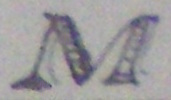 |
| In the two value panes the two lines and dots indicated are thinner and smaller in the good than in the false notes |  |
|
| In the counterfeits the letters in the two words SÉRIE are very close together and the type is thicker. | ||
| In the counterfeits the type in Á LA VISTA is very thick, especially in the letter A |
|
|
 |
 |
|
| In the portrait of Manuelita Garcia Terruel there are decided differences: 1. in the hair in the forehead (curled in the good notes) 2. in the ears and ear-rings 3. in the collar of pearls 4. in the eagle 5. in the snake 6. in the horizontal lines of the shading behind the face. |
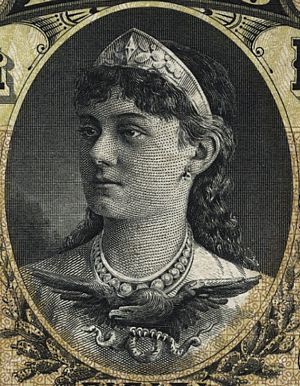 |
|
| In the vignette of Justice there are important differences: 1. in the hand holding the scales (the two fingers pointing to the right do not appear in the false notes) 2. in the scales (the left pan of the scales is indistinct in the false notes) 3. in the collar of the figure 4. There is more shading between the pedestal and the fancy curves near the counter in the counterfeit notes |
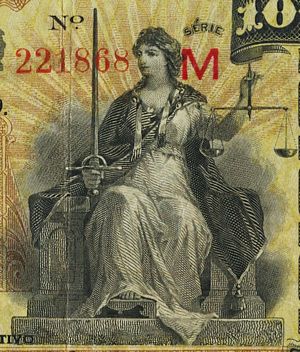 |
|
| In the counterfeits the “No” for the numeration is much blacker and of a slightly different type | ||
| The numbering in red ink and the dating in black ink are clearer and smaller in the good notes than in the false | ||
| All the engraving on the reverse is very inferior | ||
| In the good notes the right wing of the eagle has three small feathers under the wing to the extreme right and in the false notes there are only two | 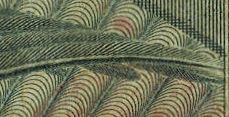 |
|
| The American Bank Note Company imprint is in clear cut type in the good notes but very bad and broken in the false notes. The full stop after the Y in COMPANY is blurred into the Y in the false notes. |
|
|
Blackmore concluded that "the imitation of the notes is inferior all round, but any person receiving an imitated note along with several good notes would be very apt to accept same."ABNC, folder 158, Banco Nacional de México (1913).
The next day, 2 May, Blackmore added that bank’s directors had not yet decided what to take as only one or two directors were present at the meeting, and they hadnow called an extraordinary Directors meeting to discuss the matter thoroughly. Legorreta, however informed him that in all probability they would decide to call in all the $100 notes and issue others with an entirely new design. The police and the public had not yet been informed, although the bank intended to let the public know imitated notes are on the market, both for the protection of the public as well as for their own protection.
On the next day, 3 May, the bank decided to call in all their $100 notes. They informed the police and issued a circular to the public, asking them to hand in their $100 notes and advising them of the major differences by which to identify any counterfeit note. They also stopped all work on the 607,000 notes ($15,000,000) that they had ordered from the ABNC on 15 April. On 7 May the ABNC’s Vice President wrote “If the Bank should decide, in view of these counterfeits, to make a change in the present notes, I would offer to have new models and engravings made, introducing some multicolor work in these notes, which will make counterfeiting much more difficult. If they would consider this and have a new issue of all the denominations made, we will prepare all these new engravings and plates without charge, simply charging them for the printing of the notes as heretofore. I don’t know whether you have some multicolor specimens among your bank notes, but if not we will gladly have a book prepared and send the same to you as soon as possible.”
The bank’s notice, as well as telling holders to exchange their $100 notes, listed the differences that Blackmore had identified:
Front:
Progressive numbering printed in red ink: in the case of legitimate notes is perfectly clear and well defined; in counterfeits, the type of printing is somewhat smaller and the printing is not very clear.
Central vignette: in the legitimate ones the figure is very clear, the hair curly, the pearl necklace very well defined; in the fake ones, the figure is poorly done, the hair without curls and the pearls of the necklace are barely distinguishable.
Righthand vignette:: in the legitimate notes, the clothing is very well defined, the hand so clear that you can count the fingers, the scales are very well made and one of the saucers is below the elbow of the figure; in the false ones, the lines of the figure are not clear, the foot is not visible and one of the scales is precisely on the arm of the figure and is not distinguishable.
Back:
Everything is very badly done in the false ones: the color is not the same and the feathers of the eagle's wings are barely distinguishable; in the good ones all the vignette is very clear and the feathers of the wings are perfectly distinguished in all their details
On 8 May, El Imparcial, a Mexico City newspaper, reproduced the notice and reasoned that the counterfeiting, by a skilled engraver, had taken place in Aguascalientes as that was where the greatest number of notes had appeared. It reported that there were $300,000 in bogus notes in circulation. It carried photographs of the front and reverse of a counterfeit note with the major differences indicted El Imparcial, 8 May 1913; notice originally in El Imparcial, 3 May 1913 and also in El Correo Español, 7 and 9 May 1913 and El Independiente, Año I, Núm. 80, 12 May 1913.
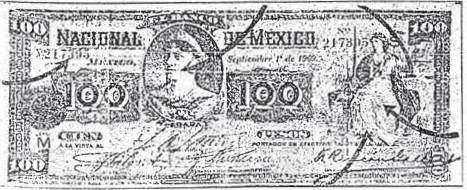
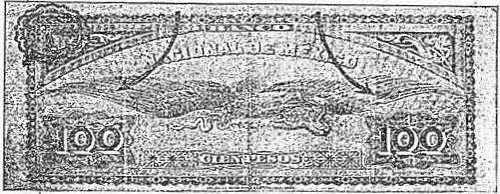
The notice when published in Guanajuato on 8 May caused consternation and holders immediately rushed to the bank's branch to exchange their notesLucio Marmolejo, Efemérides Guanajuatenses, Tomo III as no doubt happened in other cities.
On 10 May the ABNC order was changed to just 56,000 notes of $50, $500 and $1,000, as the bank had decided to use up existing supplies of the other denominations before ordering an entirely new issue.
These counterfeit $100 notes appeared in Fort Worth in June 1913 and in El Paso and Ciudad Juárez a few days laterEl Paso Herald, 7 June 1913. On 8 June El Paso detectives arrested two Mexicans, Alejandro Trujillo and J. M. Montano, jr. When arrested they had bank books of the State National bank and El Paso Bank and Trust, showing that they had deposited $2,260 in total, supposedly in these counterfeit $100 notes. They had also deposited $500 at the American Trust and Savings bank. According to the newspaper report the notes were a work of art, and the only things wrong were that the toes on the right foot of the figure of Justice were missing and the pearls in the string cannot be distinguished in the counterfeit notes, while on the genuine one, they can. The detectives believed that approximately $1,000,000 of these notes had been circulated in Mexico and some used to pay part of the Mexican army. The fact that the banks of Mexico had refused to accept $100 notes unless examined and passed by an expert, it is believed, drove the money to El Paso and parts of CaliforniaEl Paso Herald, 9 June 1913. Trujillo and Montano were bound over to the federal grand jury by United States Commissioner Oliver and their bonds were fixed at $1,500 each, but attorney J. F. Weeks filed writs of habeas corpus on the grounds of insufficient evidenceEl Paso Times, 23 June 1913.
It would be interesting if anyone could produce an example of any of these various attempts.
El Modelo advertisements
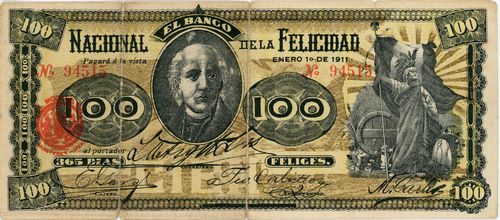
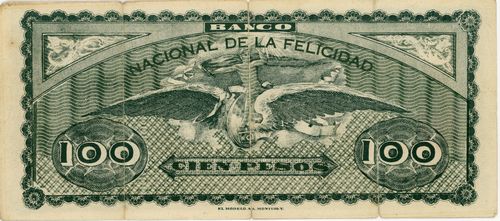
Note that these counterfeits were different from some facsimile $100 notes, used as advertising flyers, that the firm of El Modelo in Monterrey had produced to celebrtate the New Year in 1911. In May 1913 the U.S. Treasury sent an example of these to the Mexican government, claiming that they were circulating in San Antonio, Texas. The Secretaría de Hacienda acknowleged that these were not counterfeits but, nevertheless, sent out a warning to banks and to state governments to alert them and to avoid people being scammed.
These notes could be easily identified by the changes in design, the legend "Banco Nacional de la Felicidad" offering to pay "365 días felices" and the imprint “El Modelo. S. A. Monterey” on the back.

